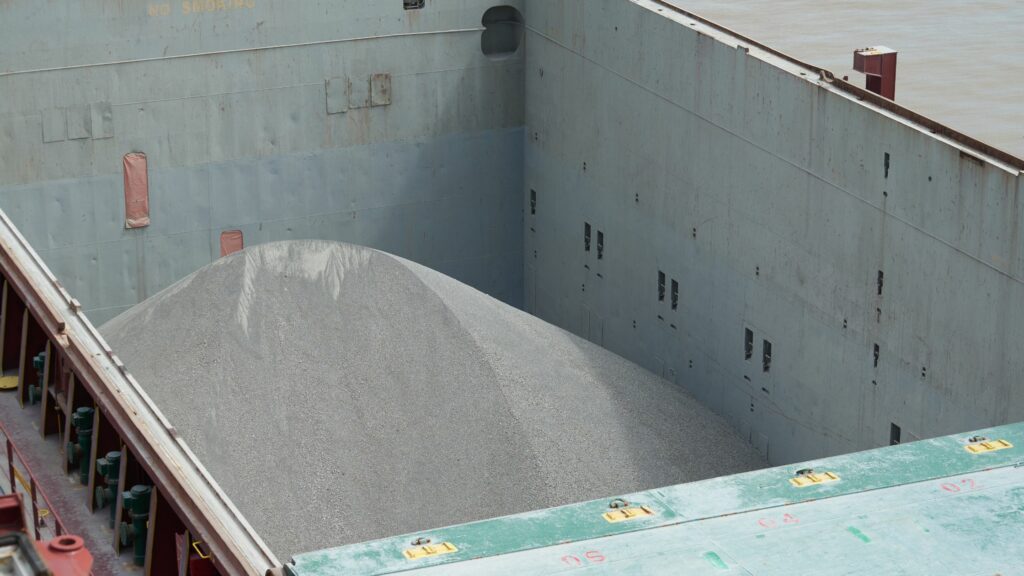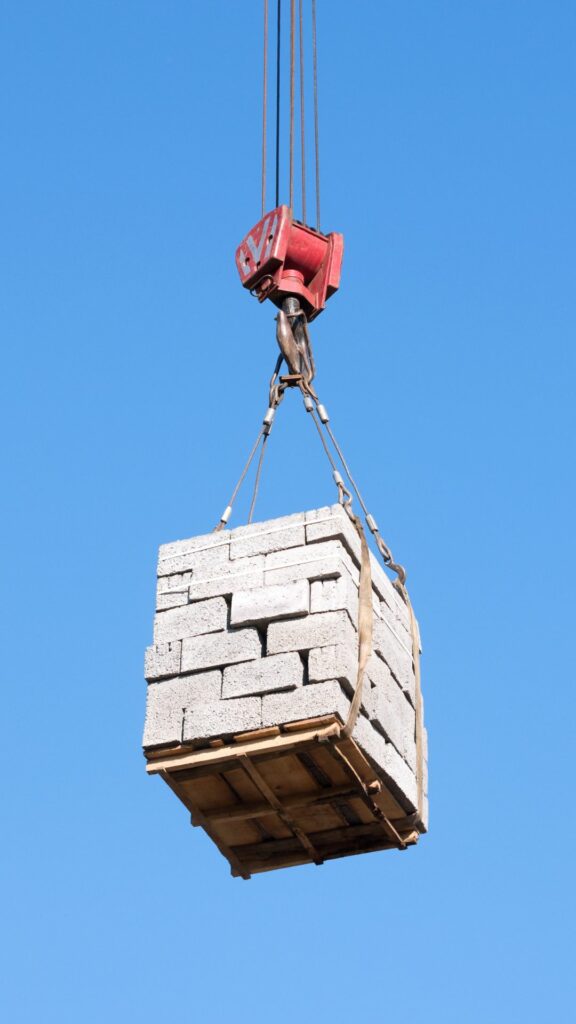Physical Address
304 North Cardinal St.
Dorchester Center, MA 02124
Bulk shipping of construction materials is often overshadowed by more high-profile commodities like oil and consumer goods. Yet, it establishes its importance through the essential role it plays in global infrastructure and development. This sector’s unique significance lies in its ability to efficiently and reliably transport vast quantities of materials critical for construction projects around the world.

This distinct sector within the maritime industry offers a specialized experience that sets bulk shipping of construction materials apart as a crucial element in the global supply chain. Key categories within this niche include the shipping of sand, gravel, limestone, and aggregates, each recognized for their indispensable role in construction. Single Grain materials also emerge within this domain, providing a lighter yet significant option for shipping needs.
Delving deeper, each category of construction material showcases its own array of characteristics, logistical requirements, environmental considerations, and economic impacts. The subsequent sections will delve into these nuances, shedding light on the production locales, preferred shipping routes, and the pivotal ports that facilitate this global trade. Through this exploration, we aim to enrich the understanding of bulk shipping’s pivotal role in supporting construction endeavors across the globe, underscoring its value as a linchpin in the edifice of international trade.
Construction materials are the backbone of the building and construction industry, encompassing a wide range of substances essential for creating infrastructure. At the heart of this category lie sand, gravel, limestone, and aggregates—each with a unique role in construction projects. Sand is pivotal for making concrete and mortar, often sourced from riverbeds and coastlines.
Gravel, extracted from quarries, lays the foundation for roads and structural bases. Limestone, crucial for cement production, contributes to the durability of structures. Aggregates, including crushed stone and recycled materials, serve various applications, from road construction to concrete mixtures.
Expanding beyond these traditional materials, the industry also sees the bulk shipping of innovative and less commonly known materials such as synthetic aggregates and advanced composites. Synthetic aggregates, produced from industrial by-products or recycled materials, offer sustainable alternatives to natural aggregates, reducing environmental impact and supporting green building initiatives. Advanced composites, combining materials to achieve superior properties, are increasingly used in construction for their strength, durability, and resistance to environmental factors.
These innovative materials highlight the evolving nature of construction projects and the importance of adapting shipping and logistics strategies to accommodate their unique characteristics and requirements. The efficient transport of these materials across the globe is made possible through bulk shipping, a specialized method that exemplifies the efficiency and reliability of maritime logistics in supporting the construction sector. This form of shipping is tailored to accommodate the unique characteristics and logistical needs of both traditional and innovative construction materials, ensuring their timely and safe delivery for infrastructure projects worldwide.
The interplay between the global trade of these materials and bulk shipping highlights the critical role of maritime transport in sustaining the construction industry’s supply chain.
The construction industry relies on a diverse array of materials, each tailored for specific purposes and applications. At the core, these materials are categorized into sand, gravel, limestone, and aggregates, all pivotal for various construction endeavors.
These materials underscore the importance of durability, safety, and sustainability in construction projects. The selection from these categories allows construction professionals to tailor material choices to specific project requirements, ensuring optimal performance and longevity. Furthermore, the global logistics network, facilitated by efficient bulk shipping, ensures these essential materials are available where and when they are needed, highlighting the intricate relationship between material selection and the global construction landscape.
Sand is indispensable in the construction world, serving as the backbone for concrete and mortar. Its unique ability to bind materials together lends strength and durability to structures. Originating from various sources such as riverbeds, coastlines, and quarries, sand’s texture and composition are critical in determining its suitability for specific construction tasks.
This versatility underpins its essential role across both residential and commercial construction landscapes.
Gravel is celebrated for its robust foundation capabilities and its integral role in concrete production. Harvested from riverbeds and quarries, gravel is distinguished by its diverse size range and smooth edges, enhancing drainage and structural stability. Beyond its structural applications, gravel also finds utility in landscaping and as a foundational layer for roads, highlighting its multifaceted use within the construction arena.
Limestone is paramount in cement production, contributing significantly to the strength and durability of concrete structures. Its beneficial chemical properties not only make it a staple in construction but also a solution for environmental pollution control. With uses extending to decorative elements, soil conditioning, and foundational material, limestone’s versatility is unmatched, marking it as a cornerstone in the construction materials domain.
Aggregates cover a broad spectrum of materials, including crushed stone, slag, recycled concrete, and geosynthetic aggregates, each serving to enhance the strength, volume, and durability of concrete and asphalt. Carefully selected based on size, composition, and application, aggregates are fundamental to the construction process. Their critical role in reinforcing structural integrity and extending the lifespan of construction projects places them at the heart of nearly all construction endeavors.

Construction materials find their origins in regions abundant in natural resources, with China, the United States, India, and various European countries leading the charge in both production and exportation. China is a powerhouse in the production of sand and aggregates, capitalizing on its extensive river systems and quarrying industry. Following closely is the United States, which boasts significant deposits of gravel and limestone, making it a key player in the global market.
India shines with its vast reserves of limestone and aggregates, positioning itself as a vital contributor to the construction materials sector. European countries stand out for their advanced quarrying technologies and are instrumental in producing and exporting limestone and aggregates. Their sophisticated practices ensure high-quality materials are available for both regional and international markets.
The strategic placement of these regions, combined with efficient maritime logistics, facilitates the bulk export of construction materials, ensuring a consistent supply chain to support global infrastructure development. This network underscores the pivotal role of these regions in sustaining the construction industry’s demands, highlighting the interconnectedness of global production and distribution.
Construction materials find their highest demand and importation in regions undergoing rapid urbanization and infrastructure expansion. Countries like the United Arab Emirates, Singapore, and various developing nations in Africa and Asia stand out as prime importers. These areas, marked by swift urban growth and economic development, require substantial amounts of construction materials to fuel their infrastructure projects.
The United Arab Emirates, for example, sources large quantities of sand and aggregates for its grandiose construction endeavors, despite its arid landscape. Similarly, Singapore’s ambitious land reclamation and infrastructure initiatives position it as a major importer of these materials. Developing countries, focused on enhancing their infrastructure and addressing housing shortages, depend on the import of construction materials to achieve their developmental objectives.
Construction materials lay the groundwork for a wide array of construction projects, encompassing residential buildings, commercial structures, roads, and bridges. Sand is crucial for producing concrete and mortar, forming the backbone of building structures. Gravel provides a solid base for roads and is a key ingredient in concrete.
Limestone plays an indispensable role in cement production, a staple in the construction process. Aggregates, which include crushed stone and recycled materials, add strength and durability to concrete and asphalt, proving essential for construction. Together, these materials guarantee the structural integrity, safety, and durability of construction projects, highlighting their pivotal role in the construction sector.
The transportation of construction materials is a critical component of the global supply chain, ensuring the timely and efficient delivery of essential resources. Bulk shipping emerges as the cornerstone for international trade, particularly for materials such as sand, gravel, limestone, and aggregates. Utilizing specialized vessels, this method is unparalleled in its capacity to move vast quantities across oceans.
For shorter distances, road transport is indispensable, offering unparalleled flexibility and access to even the most remote areas. Rail transport plays a crucial role in landlocked regions, providing an efficient and environmentally friendly option for transporting large volumes over long distances. Additionally, conveyor systems offer a direct, continuous method for moving materials from production sites to shipping areas or processing plants, optimizing the supply chain.
Together, these methods ensure the seamless and sustainable movement of construction materials, supporting the ongoing demands of the construction industry worldwide.
The global distribution of construction materials hinges on key maritime corridors that facilitate their movement. The Panama Canal and Suez Canal are paramount, acting as vital shortcuts that link major production hubs with markets across continents, thereby streamlining the supply chain. The Strait of Malacca, serving as a crucial passage for shipments from Asia, underscores the strategic importance of these routes in connecting diverse regions.
Recent expansions, such as the Panama Canal expansion completed in 2016, have significantly increased the canal’s capacity for bulk cargo ships, allowing for the more efficient transport of construction materials between the Atlantic and Pacific Oceans. Transatlantic and transpacific pathways further enrich this network, enabling materials to traverse from North America to Europe and from Asia to the Americas, respectively. These routes collectively ensure the fluid and efficient transport of construction materials, essential for supporting global infrastructure projects.
| Shipping Route | Description | Recent Developments |
|---|---|---|
| Panama Canal | Connects the Atlantic and Pacific oceans, crucial for shipments between North and South America and Asia. | The expansion project completed in 2016 allows for the passage of larger “New Panamax” ships, increasing the volume of construction materials that can be transported. |
| Suez Canal | Links the Mediterranean Sea to the Red Sea, providing the shortest maritime route between Europe and lands lying around the Indian and western Pacific oceans. | Ongoing dredging and expansion efforts aim to accommodate larger vessels and increase the canal’s capacity for bulk carriers. |
| Strait of Malacca | Narrow stretch between the Malay Peninsula and the Indonesian island of Sumatra, critical for trade routes from Asia to the Middle East and Africa. | Increased patrolling and safety measures to ensure secure passage for carriers due to its importance for global trade. |
| Transatlantic | Covers routes across the Atlantic Ocean, connecting ports in North America and Europe. | Enhanced shipping services and route optimizations to improve transit times and reduce fuel consumption. |
| Transpacific | Encompasses routes across the Pacific Ocean, linking Asia with the Americas. | Technological advancements in vessel design and routing software to increase efficiency and environmental sustainability. |
The efficiency and safety of the bulk shipping industry are fundamentally dependent on the rigorous procedures employed during the loading and unloading of construction materials. These critical operations are guided by comprehensive best practices and safety standards, aimed at minimizing risk and preserving the quality of the materials. Initially, strategic planning of cargo space is essential to maximize vessel capacity and ensure balanced weight distribution, which is pivotal for safe navigation.
Specialized equipment such as cranes, conveyor belts, and bulk loaders are at the forefront of these operations, facilitating the precise and efficient movement of materials onto and off the ships. Emphasis on safety protocols cannot be overstated, with stringent measures in place to safeguard workers against potential hazards and prevent any form of environmental pollution. Technological advancements play a crucial role in refining these loading and unloading procedures, enhancing both operational efficiency and safety.
This meticulous attention to detail ensures that construction materials are transported in optimal condition, ready to be utilized in construction projects across the globe, thereby upholding the integrity of the supply chain.

The loading and unloading of construction materials necessitate the use of specialized equipment to efficiently handle the diverse range of materials. Cranes, both mobile and stationary, are essential for lifting heavyweight materials onto and off ships. Conveyor belts streamline the movement of bulk materials, such as sand and aggregates, ensuring a continuous and efficient flow.
Bulk loaders are specifically designed for the rapid loading of materials like gravel and limestone, significantly reducing handling times. This suite of equipment is integral to the seamless transfer of construction materials, safeguarding their quality throughout the process.
The loading and unloading phases are governed by rigorous safety protocols aimed at protecting workers and the environment. The mandatory use of Personal Protective Equipment (PPE), including helmets, gloves, and safety boots, shields workers from potential hazards. Regular training sessions ensure that all personnel are versed in safety practices and emergency response procedures.
Equipment undergoes routine inspections to uphold safety standards, minimizing the risk of accidents. Additionally, measures such as dust suppression systems are employed to mitigate environmental impacts, reflecting a deep commitment to safety and environmental care.
Managing efficiency and speed in the handling of construction materials involves a strategic blend of planning, technology, and process optimization. Pre-loading planning plays a crucial role in maximizing space utilization and expediting access to materials. The deployment of automated and mechanized equipment, like conveyor systems and bulk loaders, accelerates loading and unloading activities.
Continuous workforce training enhances operational efficiency, enabling swift and secure material handling. The integration of technological innovations, such as logistics management software, streamlines operations, ensuring rapid and efficient material movement from origin to destination.
The storage and handling of construction materials are pivotal to maintaining the quality and safety of these essential resources throughout the supply chain. Effective storage solutions are meticulously designed to cater to the varied requirements of different materials, such as the need for moisture control in cement or the robust storage for aggregates. Strategies include covered storage to protect against environmental elements, controlled environments for sensitive materials, and material segregation to prevent cross-contamination and preserve integrity.
In parallel, handling practices prioritize efficiency and safety, leveraging both specialized equipment and precise techniques to transport materials without compromising their quality. The choice between automated systems and manual handling is made with careful consideration of the material characteristics and the specific demands of each project. This dual focus on storage and handling ensures that construction materials are kept in pristine condition from the moment they are stored until they are needed on site, underpinning the successful execution of construction projects globally.
The storage requirements for construction materials are pivotal in ensuring their integrity, quality, and usability are preserved. Materials such as cement and aggregates demand dry, covered environments to shield them from moisture, which could impair their structural qualities. Steel and other metals need to be stored in conditions that prevent corrosion, while temperature-sensitive materials like asphalt require controlled environments to maintain their properties.
Effective labeling and segregation are essential for preventing cross-contamination and facilitating straightforward identification and access, keeping materials in prime condition for use.
In both storage and transit, handling of construction materials is executed with meticulous care to avoid damage and maintain quality. Automated handling systems, such as conveyor belts and forklifts, provide efficient and precise movement. Manual handling remains crucial for materials that demand gentle care, relying on skilled labor to ensure safe loading, unloading, and stacking.
The handling method is selected based on the material’s characteristics and transit requirements, always adhering to strict safety standards and efficiency protocols to minimize damage risk.
Risk mitigation strategies for construction materials are designed to prevent loss, damage, and project delays. Inventory management systems offer comprehensive tracking of materials from delivery to deployment, mitigating the risk of inventory discrepancies. Quality control checks at storage, during handling, and in transit ensure materials meet all specifications.
Insurance coverage provides a financial safety net against potential losses. Moreover, ongoing training for personnel on proper handling and safety measures reduces accidents and material waste, securing the supply chain against unforeseen disruptions.
International regulations play a crucial role in ensuring the safety, environmental protection, and quality of construction materials across the global supply chain. The International Building Code (IBC) establishes comprehensive standards for building construction, encompassing the usage and properties of materials. The International Maritime Organization (IMO) sets forth guidelines for the safe transportation of hazardous materials, affecting how certain construction materials are shipped.
Environmental considerations are addressed through regulations like the Basel Convention, which governs the movement of hazardous wastes, including those from construction materials, to safeguard human health and the environment. Additionally, trade agreements and customs regulations in various countries influence the import and export of construction materials, shaping global trade practices. Collectively, these regulations form a robust framework that supports sustainable development and ensures fairness and safety in the international construction materials marketplace.
Meeting compliance requirements for construction materials is essential for ensuring their safety, quality, and environmental sustainability. These materials must adhere to the International Building Code (IBC), which specifies standards for their properties and use in construction projects. For materials involved in international transport, adherence to International Maritime Organization (IMO) regulations is crucial, especially for hazardous materials, to guarantee safe shipping practices.
Environmental compliance is also mandatory, guided by the Basel Convention and local environmental laws, which dictate the proper handling and disposal of hazardous wastes and encourage the use of sustainable materials. Moreover, materials need to conform to ISO standards, affirming their quality and fitness for construction purposes against international benchmarks.
The oversight of construction materials trade is conducted by several key regulatory bodies, each integral to upholding international standards. The International Maritime Organization (IMO) plays a critical role in regulating the safe transport of materials, with a particular focus on hazardous categories. The World Trade Organization (WTO) monitors trade policies and agreements, influencing the import and export of construction materials to ensure equitable trade practices.
Environmental regulations fall under the purview of the United Nations Environment Programme (UNEP), aligning with the Basel Convention to mitigate the environmental impact of construction materials. National standards organizations, such as ASTM International and ISO, are also pivotal, setting the quality and safety standards for construction materials to meet required international criteria.
The global transportation of construction materials underscores several ecological concerns that demand immediate and effective action. A significant issue is the carbon footprint generated by the long-distance shipping of these materials, which contributes substantially to greenhouse gas emissions and, consequently, climate change. The risk of water pollution also looms large, with potential spills and the discharge of ballast water posing threats to marine ecosystems by introducing invasive species and harmful pollutants.
Habitat disruption, resulting from the dredging required to extract materials like sand, further impacts aquatic biodiversity and ecosystems negatively. For example, extensive sand mining operations have led to the degradation of coral reefs and riverbeds, disrupting habitats for marine and riverine species. On land, the extraction of construction materials often leads to land degradation and a loss of biodiversity, exacerbating the environmental footprint of construction projects.
The removal of topsoil and vegetation for limestone quarrying, for instance, has resulted in soil erosion and loss of habitat in several regions. Addressing these ecological concerns is imperative, highlighting the urgent need for the adoption of sustainable practices in the extraction and transportation of construction materials to strike a harmonious balance between development and environmental conservation.
The shipping of construction materials encounters several common challenges that can affect the efficiency, cost-effectiveness, and environmental sustainability of operations. Logistical complexities are a major hurdle, requiring meticulous coordination to move vast quantities of materials across international borders, often involving multiple modes of transport. The need for regulatory compliance with diverse international and local standards complicates the process further, making cross-border shipments especially challenging.
Environmental concerns also play a significant role, as the industry strives to reduce emissions and prevent pollution, necessitating sustainable shipping practices. Additionally, the volatility of fuel prices poses a financial challenge, directly impacting the cost of shipping and, consequently, the overall budget of construction projects. Navigating these challenges demands innovative approaches and strategic planning to ensure the smooth and sustainable transport of construction materials worldwide.

The shipping market for construction materials is ripe with opportunities amidst the backdrop of global infrastructure expansion and urbanization. Technological advancements stand as a beacon for enhancing operational efficiency and slashing costs, leveraging optimized logistics and automated systems. The shift towards sustainability heralds new prospects for adopting green shipping practices and sourcing renewable or recycled materials, aligning with the global call for environmental stewardship.
Emerging markets in Asia and Africa, fueled by rapid urban development, beckon with untapped potential for market growth. Moreover, the advent of smart cities and green building projects underscores the demand for specialized shipping services for sustainable and high-performance materials, positioning companies to capitalize on the evolving landscape of construction and environmental consciousness.
The horizon looks bright for the shipping of construction materials, characterized by robust growth and a wave of innovation. The industry’s trajectory is steering towards sustainability, with concerted efforts to diminish environmental impacts and boost efficiency. The embrace of digital technologies—including blockchain, the Internet of Things (IoT), and artificial intelligence (AI)—promises to revolutionize operations, enhancing tracking, transparency, and cost-effectiveness.
Insights into emerging trends such as the use of blockchain for supply chain transparency offer a forward-looking perspective on the industry’s evolution. The development of greener construction materials that require specialized shipping underscores the sector’s move towards more sustainable practices. These innovations not only aim to improve operational efficiencies but also address the growing environmental concerns associated with the shipping of construction materials.
Anticipated to surge, the demand for construction materials will be propelled by worldwide infrastructure initiatives and urbanization projects. Yet, the sector must adeptly navigate the waters of regulatory shifts, environmental challenges, and geopolitical uncertainties. Poised for a transformative journey, the construction materials shipping industry is set to evolve, with sustainability and technological innovation leading the charge into the future.